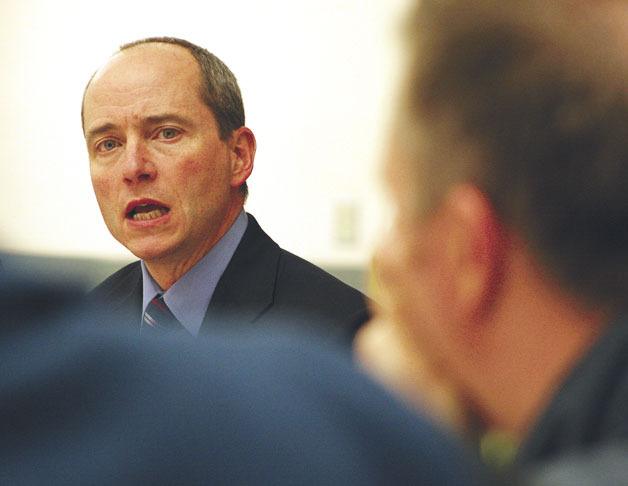LANGLEY — Wait and listen.
Expect it to cost taxpayers more.
And don’t think construction will be completely wrapped up at the high school in time to meet the fall 2012 deadline for closing Langley Middle School and moving students to a combined campus on Maxwelton Road.
That’s the condensed version of what consultants think about the South Whidbey School District’s consolidation effort. The district’s outside experts met this week with the school board for the first time since the district’s $25 million bond measure failed at the polls in November.
School board members gathered in a special workshop Wednesday to get a broad overview of the options for resubmitting a bond measure to voters.
Jim McNeill, a bond attorney with the law firm Foster Pepper, said school districts that suffer sizable losses at the ballot box — those that get less than 55 percent of the “yes” vote — typically take a timeout before resubmitting bond measures to the public. South Whidbey’s bond measure was rejected with a 56-percent “no” vote (a 60-percent “yes” vote was needed for passage).
“Generally, they don’t immediately go back to their voters. They take time, gather information, either via survey or public forums,” McNeill said.
“Many districts will take a fair number of months — if not a full year — to go back and really consider what happened, why it happened, and really get the information they need from the public to figure out where they need to go,” he said.
McNeill said the school district must find out what the community wants and what it will support.
“Generally when you see districts falling in those ranges of approval, something is amiss,” he said.
“I think it would be different if you had come close,” he added. “You could say, ‘Well, gee, a lot of no voters come out in November,’ so we could probably go back again in February or April and have a better chance.”
“This situation, given your percentage, again I would not recommend that,” McNeill said.
Most of the money coming from the $25 million bond measure — about $15 million — would have been spent to build new classrooms and make other improvements at South Whidbey High School to accommodate the move of the middle school by fall 2012. The school board recently decided against rerunning the bond measure in February, and McNeill noted that February is the best month for bond elections.
Most voters are accustomed to school measures on the ballot then, when maintenance-and-operations levy requests are typical.
School districts have also seen success at the ballot box during April and May, he added, and this year, more school districts have been eyeing April elections (10 or 12 currently planned for April and May, compared to nine on the ballot in February, he said).
That said, McNeill said the school district may not have enough time to gather feedback from the community to get another bond proposal ready in time for the May election.
Then the tough call becomes, he said, deciding whether to wait for February or go to voters in August or November. And in August, school is out and it’s harder to connect with voters.
Jim Blumenthal, a senior municipal underwriter with Martin Nelson and Co. of Seattle, said interest rates were rising in the municipal bond market, and uncertainty over the economy was fueling volatility in the market.
“The market’s a little jittery,” he said.
If the school district passes a bond measure, officials can expect to see higher interest rates, and property owners will pay more for the same bonds than they would have had November’s election been successful.
Combined with the drop in the assessed value of property in the school district — a nearly 15-percent decline in value in 2010 and 2011 — the district is looking at a 5- to 7-cent increase in the tax rate for property owners above the amount requested in November.
November’s ballot measure was built on a tax rate of 47 cents per $1,000 of assessed property value; if the district now pursues a $25 million bond measure, the rate would climb to 52 cents per $1,000 of assessed property value. That means owners of a $350,000 property would pay an additional $17.50 per year above what they would have paid if November’s bond measure were approved (an increase from $164.50 to $182 annually for the bond).
In terms of debt, a bond measure would not overextend the district’s capacity, Blumenthal added.
The district has a debt capacity for general obligation bonds (ones that voters must approve) of $177 million, and also has non-voted debt capacity of $15 million.
Blumenthal outlined four scenarios for a new bond, ranging from $10 million to $32 million, which would include $7 million that could be spent to convert Langley Middle School to a non-school use.
McNeill noted that the district wouldn’t be able to spend bond proceeds to fix up the middle school and then sell it.
“Municipalities … can’t fix up something, and then turn around and sell it to a private party. The Constitution doesn’t allow you to do that,” he said.
Some school districts have, however, turned surplus facilities into community centers.
School district officials had hoped to close LMS by fall 2012.
But Brian Fitzgerald, an architect with TCF Architecture, presented timelines that showed construction would not be finished until August 2013 at the earliest.
Even with an accelerated schedule after a May bond election, the completion of construction and building occupancy wouldn’t come until August 2013.
District Superintendent Fred McCarthy has asked the school board to rethink its consolidation target of fall 2012, but the board has yet to have in-depth discussions on McCarthy’s recommendation.
The board will have another workshop devoted to bond issues on Feb. 2.



